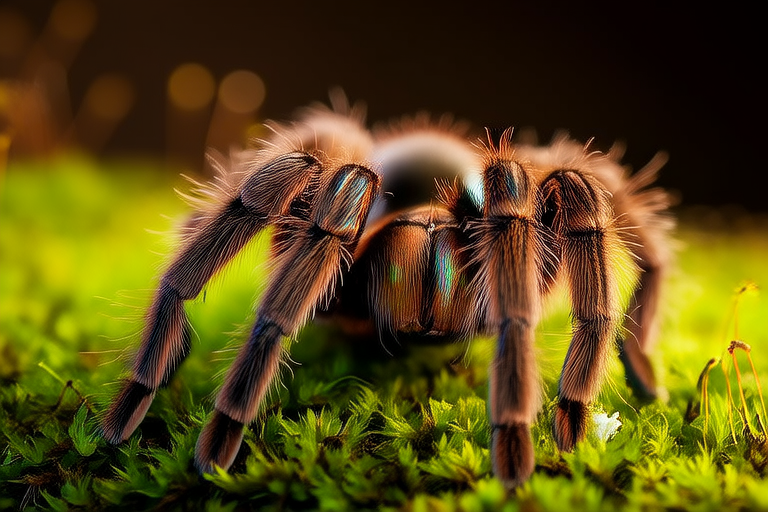The Chilean Rose Tarantula: An In-Depth Exploration
The Grammostola rosea, commonly known as the Chilean Rose Tarantula, is one of the most popular and widely kept pet tarantulas due to its docile nature and manageable size. Originating from the deserts and scrublands of Chile, Argentina, and Bolivia, this spider is celebrated for its unique appearance and fascinating behaviors. This article delves into the various aspects of the Chilean Rose Tarantula, covering its physical characteristics, habitat, behavior, diet, care requirements, and its role in conservation.
Appearance and Naming
The Chilean Rose Tarantula is named for its pinkish-brown coloration, which often appears rosy under certain lighting conditions. Its body is covered in fine hairs that give it a silky appearance, hence the moniker “Silky Spinners.” These hairs are not only aesthetically pleasing but also serve practical purposes, such as detecting vibrations and protecting the spider from predators by causing irritation if brushed against an attacker’s skin. The spider has a robust, round body with long, thin legs that are well-adapted for both walking and climbing. Females can grow up to 4 inches (10 cm) in length, while males are slightly smaller at around 3 inches (7.5 cm).
Habitat and Adaptations
Native to the arid regions of South America, the Chilean Rose Tarantula thrives in environments characterized by sparse vegetation and limited water sources. Their natural habitat includes desert and scrubland areas where they seek refuge in burrows or crevices. These spiders have adapted to their surroundings by developing nocturnal habits, emerging at night to hunt for food while avoiding the intense heat of the day. Their ability to move stealthily, thanks to their soft, velvety feet, allows them to navigate through their environment without making much noise. This stealthy movement is crucial for both hunting and evading larger predators.
Behavior and Diet
Chilean Rose Tarantulas are generally non-aggressive and prefer to retreat rather than attack when threatened. In the wild, they are solitary creatures, living alone except during mating season. They are primarily ground-dwelling, though they can climb trees or other structures in search of prey. Their diet consists mainly of insects like crickets, grasshoppers, and moths, but they may also consume small vertebrates such as lizards or baby mice. In captivity, these spiders are fed appropriately sized insects every week or two, depending on their age and size.
Threats and Interactions in the Wild
In the wild, Chilean Rose Tarantulas face several threats, including predation by birds, mammals, and other large spiders. They have developed defensive mechanisms such as playing dead, releasing irritating hairs, or biting if cornered. However, their main threat comes from human activities, particularly habitat destruction caused by urbanization and agriculture. Conservation efforts aim to protect these spiders and their habitats, ensuring that future generations can appreciate these remarkable creatures.
Breeding Habits
Breeding occurs during the rainy season, typically between September and November. Males produce sperm packets called spermatophores, which females pick up and store until they are ready to lay eggs. After mating, the female constructs a silk-lined egg sac containing up to 500 eggs. She guards this sac fiercely, rarely leaving it until the spiderlings hatch after about six weeks. Once hatched, the spiderlings remain with their mother for several weeks before dispersing to find territories of their own.
Pet Trends and Care Tips
Despite being popular pets, there are many misconceptions about keeping Chilean Rose Tarantulas. One common myth is that they make ideal first-time spider pets due to their docility; however, handling should be minimized to prevent stress and injury. Another misconception is that these spiders require minimal care. While relatively low-maintenance compared to some other exotic pets, they still need appropriate housing, temperature control, humidity levels, and regular feeding schedules. Proper care involves providing a spacious terrarium with hiding spots, maintaining temperatures between 75°F and 85°F (24°C to 29°C), and ensuring adequate ventilation.
Conservation Efforts
Conservation plays a vital role in preserving the Chilean Rose Tarantula population. Habitat protection initiatives focus on safeguarding their natural homes from deforestation and pollution. Additionally, responsible breeding programs help maintain genetic diversity within captive populations, reducing the need for wild-caught specimens. By supporting these efforts, enthusiasts contribute positively towards the survival of this fascinating species.
Conclusion
The Chilean Rose Tarantula is a remarkable creature with unique adaptations suited to its harsh desert environment. Understanding its biology, behavior, and needs helps ensure its continued existence both in the wild and as beloved pets. As we continue to learn more about these spiders, it becomes increasingly clear why they deserve our attention and protection. Through education, responsible ownership practices, and active participation in conservation projects, we can secure a future where these beautiful creatures thrive.
